Duval County, Florida
Sphingidae Larva
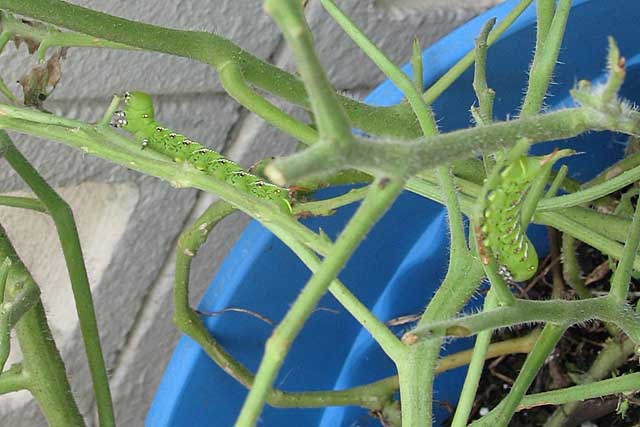
Manduca sexta, Jacksonville, Duval County, Florida,
August 18, 2008, courtesy of Sabrina Carmichael.
|
|
Inspired/dedicated as per personal communication with Sabrina Carnmichael (Manduca sexta, August 19, 2008); August, 2008 Updated as per James P. Tuttle's The Hawk Moths of North America, August 2008 Updated as per personal communication with Amanda Carta (Isoparce cupressi, September 13, 2012): September 15, 2012 Updated as per personal communication with Josh Malunas and Julie Happy via Daniel Marlos (Isoparce cupressi, April 11, 2015): April 15, 2015 |

For care of "found larvae/caterpillars" visit Manduca sexta larva, central Texas, August 21, 2008, Trina Woodall.
This page is inspired by and dedicated to Sabrina Carnmichael who found the Manduca sexta larvae depicted top and bottom of this page.
Sabrina writes, August 19, 2008, "My name is Sabrina and I've been having an issue this year with caterpillars eating my tomato plants.
The latest are these green ones which I haven't seen before. I live in Jacksonville, Florida out at the Atlantic Beach area.
I have found as many as 20 plus on one plant. Attached are some pics of the ones (bottom of page) I did manage to get off the plants.
I did look them up and I found that these are supposed to be from Costa Rica. Is it typical to find them here in the states?"
I replied, "They are Manduca sexta caterpillars (note the red horn). This species flies throughout most of the eastern United States all the way to southern Maine. I used to find them on my grandfathers' tomato plants in New Jersey.
"My Duval County Sphingidae checklist is at Duval County Sphingidae. You can see adult moths and read more about them there.
"I have a special request. I would like to make a thumbnail checklist of the Duval County Sphingidae larvae and would like to feature an electronic image by you at the top of the page. Would you please go out and find another one on your tomato plants and take a nice picture of it in natural settting and send the image before you destroy the caterpillar.
"They also fly in Costa Rica and in much of South America."
The image Sabrina sent with her reply, "Thank you for the info and I'll check out the website. As you can see it didn't take long for them to consume the plant. Here are the pics," clearly shows how much damage these larvae can do to a tomato plant.
The larvae are scarcely noticeable when they are young, but when they reach the fourth and fifth instars, they can consume tremendous amounts of foliage in a single day. Most of the other Sphingidae species have larvae which are not considered as pests.
Sixty-five Sphingidae species are listed for Florida on the U.S.G.S. website. Not all of the species are reported or anticipated in Duval County (Fourteen species are reported on U.S.G.S. as of August 20, 2008. Please do not interpret this as a criticism of the U.S.G.S. data. Their mandate is accuracy; mine is help. Their data from surrounding areas has greatly assisted me in assembling this tentative checklist.) It is hoped that this checklist, with the thumbnails and notes, will help you quickly identify the Sphingidae larvae you are likely to encounter.
A "WO" after the species name indicates that I have no confirmed reports of this species in Duval County, but I (William Oehlke) expect that this moth is present or might be present.
A "USGS" indicates the moth is reported on the USGS website and/or in Lepidoptera of North America, #1. Distribution of Silkmoths (Saturniidae) and Hawkmoths (Sphingidae) of Eastern North America, an excellent little booklet available through Paul Opler.
Please help me develop this list with improved, documented accuracy by sending sightings (species, date, location), preferably with an electronic image, via email to Bill Oehlke.
Many thank to Amanda Carta who provides the following image of Isoparce cupressi.
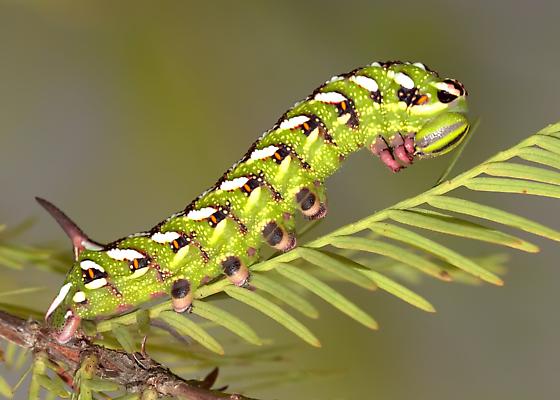
Isoparce cupressi larva, Duval County, Florida,
September 13, 2012, courtesy/copyright Amanda Carta.
I reply, "Thanks for permission to post image. Most of the Sphingidae do not make the cocoons typical of many of the giant silkmoths, Saturniidae.
Instead, the Sphingidae larvae either pupate in leaf litter, loosely held together by a few strands of silk, at soil surface, or
they excavate subterranean chambers, sometimes six inches or more in depth, and pupate underground.
This larva seems almost mature so you can treat it as per the article about care of found larvae near topof this page. Best of luck.
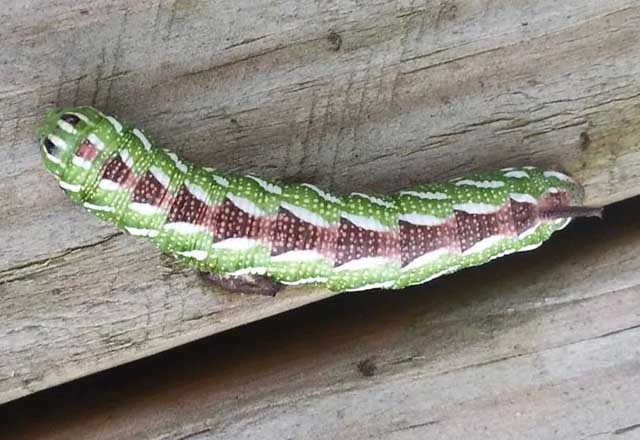
Isoparce cupressi fifth instar, Jacksonville, Duval County, Florida,
April 11, 2015, courtesy of Josh Malunas and Julie Happy, via Daniel Marlos.
Visit Duval County, Florida, Adult Sphingidae
The night-blooming moon flower will attract many
Sphingidae at dusk and into the night.
Please also send your sightings to BAMONA, an excellent on-line resource.
Larvae feed on Elm (Ulmus), birch (Betula), basswood
(Tilia), and cherry (Prunus).
There are both green and brown forms. The four horns near
the head are diagnostic.
Young caterpillars feed gregariously on Catalpa species
(Catalpa bignoniodes and C. speciosa) in the
Bignoniaceae family, skeletonizing the foliage.
Larvae are mostly white in early instars.
Fraxinus, Ligustrum, Quercus, Crataegus and
Chionanthus virginicus are listed as hosts.
In the fifth instar, the spiracular ovals are decidedly red and the
anal horn is off-white to pinkish laterally.
Larvae feed upon various pine species, including loblolly pine
(Pinus taeda) and longleaf pine (P. pinaster). They are well
camouflaged and are without an anal horn.
Larvae feed on ash in the Fraxinus genus. Syringa and Ulmus have
also been reported.
Note the black anal horn.
The caterpillars are called Tomato Hornworms and each has a black horn at the end of the abdomen.
Larvae feed on potato, tobacco, tomato, and other plants in the
nightshade family (Solanaceae).
Tobacco Hornworms, equipped with a red-tipped horn at the end of the
abdomen, are true gluttons and feed on tobacco and tomato, and
occasionally potato and pepper crops and other plants in the
nightshade family (Solanaceae).
Preferred hosts are common trumpetcreeper (Campsis radicans),
Florida yellow-trumpet (Tecoma stans), lilac
(Syringa species), and
passionflower (Passiflora species).
The anal horn is blue, preceded by a yellow dash.
Larval hosts are apple (Malus), sweetfern (Myrica), Carolina rose
(Rosa carolina), blueberry and huckleberry (Vaccinium), white spruce
(Picea glauca), American larch (Larix laricina), and alder (Alnus).
Amorpha juglandis larvae feed upon Walnut and butternut (Juglans),
hickory (Carya), alder (Alnus), beech (Fagus),
hazelnut (Corylus), and hop-hornbeam (Ostrya).
Pale green eggs are deposited on hostplants foliage and this sphinx will oviposit readily on the insides of brown paper sandwich or grocery bags.
Blueberry and huckleberry (Vaccinium), cherries (Prunus) and willows (Salix) are the favorites as larval foodplants.
Larvae accept willows, birches, and cherries.
I have also found them in the wild on oak in eastern Canada.
The skin is very granulose.
The larvae depicted is probably third instar.
There may be more red spotting on the sides
as larvae mature.
Larvae feed upon many forest trees including birches and cherries,
but are expecially fond of poplars and willows. Red markings on sides
vary greatly from specimen to specimen.
The body and wings are dark brown. The forewing has a large black
patch covering most of the outer half of the wing. There is a pale
tan cell spot (dark inner pupil), and a fairly straight median line
to the inside of the cell spot.
There is also an orangey-pink prepupal form. The lateral line runs
from S1 to the blue horn.
Hemaris thysbe larvae feed on viburnum and related plants.
Larval foods are blueberries including low bush blueberry
(Vaccinium vacillans), and laurel (Kalmia), all in the heath family
(Ericaceae).
Larvae feed upon Grape (Vitis), Virginia Creeper
(Parthenocissus quinquefolia) and other vines and ivies
(Ampelopsis).
Larvae occur in both a light (green) form and a darker (tan/brown)
form. Note six "segmented" oblique lines.
Look for large, dark spiracular circles, a dark
line in the center of the back, and seven white oblique stripes.
Eumorpha intermedia larvae feed upon peppervine, Ampelopsis arborea. Possibly they will also accept grape (Vitis species),
but so far no records of that host have been reported to my knowledge.
They like to remain well hidden within tangle of vines and probably feed mostly at night.
If you have Grape or Virginia Creeper nearby, then you might encounter
this species. Note the five large white ovals. There are orangey-brown and green
forms also.
In additon to Virginia creeper larvae accept Grape (Vitis),
ampelopsis (Ampelopsis), and cayenne pepper (Capsicum).
Larvae are green until the final instar.
Larvae feed on Azalea and Viburnum and progress very rapidly. The
larva to the left on Viburnum cassinoides is getting ready to
pupate. Color change from green to light burgundy-brown indicates
pupation is imminent. If you have the
foodplants indicated in the common names, you probably have this
species nearby. The lower wings are orange.
Larvae feed on Virginia creeper (Parthenocissus quinquefolia),
Grape (Vitis), Ampelopsis, and Viburnum.
Larvae turn a deep chocolate brown just prior to pupation, and the
"horn" on the tail also turns downward as pupation draws near.
Darapsa versicolor larvae feed on Smooth hydrangea
(Hydrangea arborescens), buttonbush
(Cephalanthus occidentalis), and waterwillow
(Decodon verticillatus).
Grape (Vitis), ampelopsis (Ampelopsis), and
Virginia creeper (Parthenocissus) all serve as larval hosts.
The alternating yellow and greyish-green rings across the back
distinguish this larva. southern range limit
Larvae are highly varied and feed on a great diversity of plants
including willow weed (Epilobium), four o'clock (Mirabilis),
apple (Malus), evening primrose (Oenothera), elm
(Ulmus), grape (Vitis), tomato (Lycopersicon),
purslane (Portulaca), and Fuschia. Larvae feed on (Onagraceae) including evening primrose
(Oenothera), gaura (Gaura), and willow weed
(Epilobium).
rare
Larvae feed at night on grape (Vitis) and ampelopsis
(Ampelopsis) and hide on the bark of their host plants during
the day. Virginia creeper would also be a suitable host. There is also a dark form
without the green patches. Note the "raised eye", replacing the anal horn.
Larvae also feed on Borreria, Catalpa and Manettia spp. and
Smooth buttonplant (Spermacoce glabra) and starclusters
(Pentas species). They are also recorded on joe-pie weed and
Hamelia patens and on Hedoydis nigricans. The green form may be more
common.
Enjoy some of nature's wonderments, giant silk moth cocoons.
These cocoons are for sale winter and fall. Beautiful Saturniidae moths will emerge the following spring and summer.
Read Actias luna rearing article.
Additional online help available. Eggs of many North American species are offered during the spring and summer. Occasionally
summer Actias luna and summer Antheraea polyphemus cocoons are available. Shipping to US destinations is done
from with in the US.
Use your browser "Back" button to return to the previous page.
This page is brought to you by
Bill Oehlke and the
WLSS. Pages are on space rented from Bizland. If you would like
to become a "Patron of the Sphingidae Site", contact Bill.
Please send sightings/images to Bill. I will do my best to respond to requests for identification help.
I very much appreciate all the many images that have been sent to me, or of which I have been granted permission to copy and post from other websites.
All images on this site remain the property of respective photographers.
If you would like to contribute to the maintenace of this website by sending a contribution to
Bill Oehlke
your donation would be much appreciated and would be used for
If you are mailing a check from USA, please use $1.15 (2015 rate) postage. Donations can also be made through Paypal via the button below.
Visit Florida Underwing Moths (Catocala).Sphinginae subfamily

Agrius cingulata,
WO Pink-spotted hawkmoth,
Larvae feed on plants in the Convolvulaceae family, especially
Ipomoea batatas (sweet potato) and in the Solanaceae family,
especially (Datura) (jimsonweed) and related plants in the
Americas. There is also a brown form. Look for very large, dark
spiracular circles. Very variable!

Ceratomia amyntor
WO,
the Elm Sphinx or Four-horned Sphinx

Ceratomia catalpae
WO,
the Catalpa Sphinx

Ceratomia undulosa
USGS, the Waved
Sphinx

Dolba hyloeus
USGS, the Pawpaw Sphinx
Larvae feed on pawpaw (Asimina triloba), littleleaf sweetfern
(Myrica aspleniifolia), possum haw (Ilex decidua), and
inkberry (Ilex glabra) as well as Tall Gallberry Holly
(Ilex coriacea).
Louis Handfield reports larvae probably feed on Ilex verticellata
in Quebec.
Isoparce cupressi, September 13, 2012, Amanda Carta.
Isoparce cupressi
USGS/AC/JM&JH, Cypress or Baldcypress Sphinx.
Larvae feed on needles of baldcypress (Taxodium distichum) at night and
pupate in shallow underground burrows where second generation overwinters.
Isoparce cupressi, Jacksonville, found on the banks of the St. Johns River, April 11, 2015, Josh Malunas &Julie Happy, via Daniel Marlos.
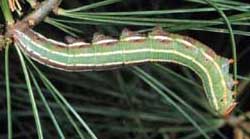
Lapara coniferarum
USGS, the Southern Pine Sphinx
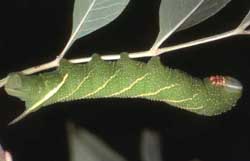
Manduca jasminearum
WO, the Ash Sphinx

Manduca quinquemaculata
WO,
the Five-spotted Hawkmoth

Manduca rustica
USGS, the Rustic Sphinx
The caterpillar has numerous white nodules on top of the thorax and
seven pairs of oblique, blue-gray stripes along the side of the body.
The horn is white at the base and blue-gray at the tip. Many hosts
are utilized.

Manduca sexta
SC, the Carolina Sphinx

Paratrea plebeja
USGS, the Plebeian Sphinx

Sphinx gordius
WO, the
Apple Sphinx
Smerinthini Tribe:

Amorpha juglandis
WO,
the Walnut Sphinx
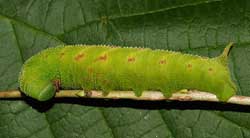
Paonias astylus
WO, the Huckleberry Sphinx

Paonias excaecata
USGS,
the Blinded Sphinx

Paonias myops
USGS, the Small-eyed Sphinx

Smerinthus jamaicensis
WO,
the Twin-spotted Sphinx
Macroglossinae subfamily
Dilophonotini tribe:
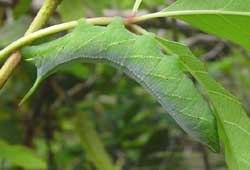
Enyo lugubris, the Mournful Sphinx,
WO

Erinnyis alope
WO, the Alope Sphinx.
Larvae have several forms and feed on papaya (Carica papaya),
nettlespurge (Jatropha), and allamanda (Allamanda).

Hemaris thysbe
WO, the Hummingbird Clearwing

Hemaris diffinis
WO, the
Snowberry Clearwing or Bumblebee Moth
Larval host plants include Snowberry (Symphoricarpos),
honeysuckle (Lonicera), Coralberry, viburnums, Blue Dogbane
(Apocynum) and dwarf bush honeysuckle (Diervilla lonicera).
Horn is black with a yellow base. southern range limit

Hemaris gracilis
WO, the
Slender Clearwing or Graceful Clearwing
Philampelini tribe:

Eumorpha achemon
USGS,
the Achemon Sphinx
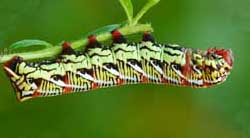
Eumorpha fasciatus
USGS, the Banded Sphinx
Larvae feed upon primrose-willow, Ludwigia (water primrose)
and other plants in the evening primrose family. This hornless larva is
highly variable. 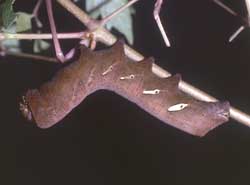
Eumorpha intermedia
WO, the Intermediate Sphinx

Eumorpha pandorus
WO, the Pandorus Sphinx
Macroglossini tribe:

Amphion floridensis
USGS,
the Nessus Sphinix

Darapsa choerilus
WO, the Azalea Sphinx

Darapsa myron
USGS, the Virginia Creeper Sphinx or the Grapevine Sphinx

Darapsa versicolor
WO,
the Hydrangea Sphinx

Deidamia inscriptum
WO,
the Lettered Sphinx

Hyles lineata
WO, the White-lined Sphinx
All larvae seem, however, to have the red/black swellings split by
dorso-lateral lines.
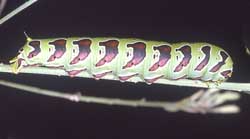
Proserpinus guarae
WO,
the Proud Sphinx

Sphecodina abbottii
WO,
the Abbott's Sphinx
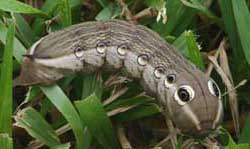
Xylophanes tersa
USGS,
the Tersa Sphinx
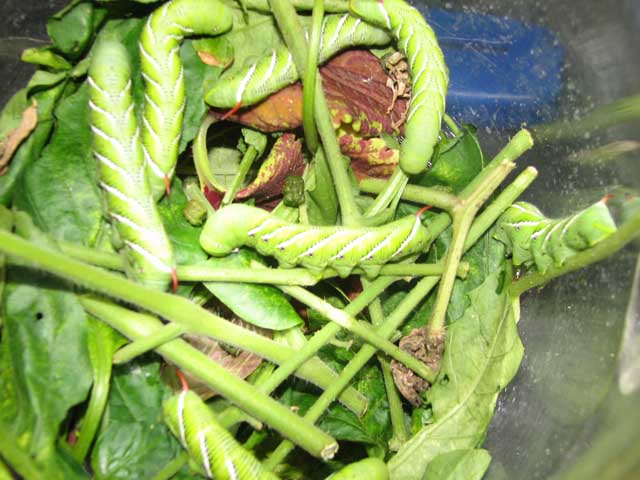
Manduca sexta, Jacksonville, Duval County, Florida,
August 18, 2008, courtesy of Sabrina Carmichael.


Show appreciation for this site by clicking on flashing butterfly to the left.
The link will take you to a page with links to many insect sites.
Box 476
155 Peardon Road
Montague, Prince Edward Island, C0A1R0
Canada
1) paying for webspace rental;
2) paying for computer maintenance and software upgrades;
3) purchases of additional text reference material (journals and books) in anticipation of expanding the site to a worldwide Sphingidae site;
4) helping to pay my daughter's tuition (completed spring of 2013); with anything left over going to humanitarian aid.